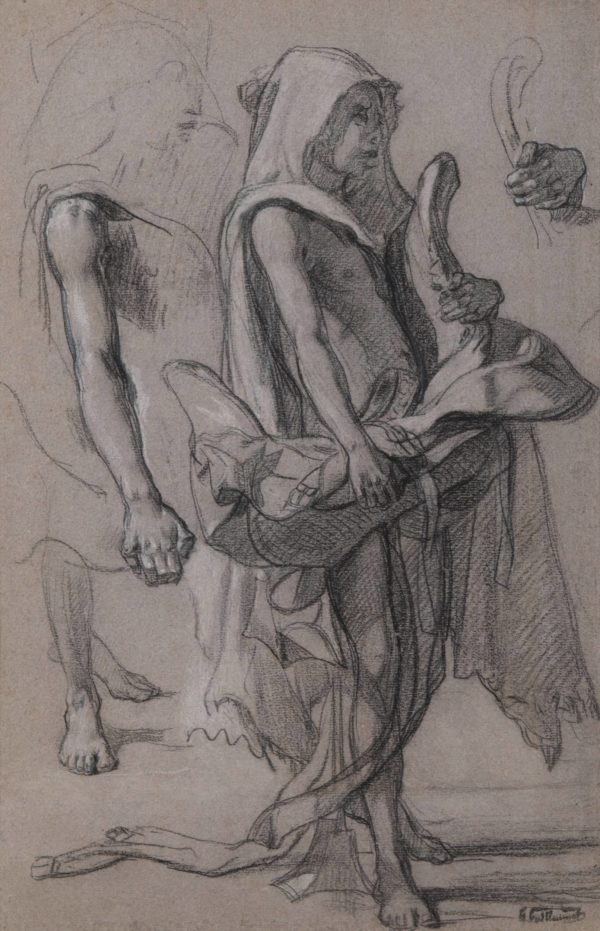Young Bedouin, study for “The Arab Market In The Tocria Plain”, c. 1865
Black chalk and white gouache on paper , H. 480 mm; W. 300 mm
Signature stamp lower right: G. Guillaumet
Provenance: Private collection, France
Following on from Fromentin and Léon Belly, Guillaumet made a significant contribution to the renewal of Orientalism during the years 1860-1880. A naturalist for his focus on documentary precision and nuances of natural light, his painting was also marked by his education at the École des Beaux-Arts. From 1857 Guillaumet attended the classes of François-Édouard Picot and Félix Barrias there. He won the second prize of the Prix de Rome for historical landscape in 1861 and nevertheless decided to go to Italy. In Marseille where he was delayed by a storm, by chance there was a boat leaving for Alger. He took it and was charmed by Algeria. During this first journey, after three months spent in the hospital of Biskra for malaria, he accumulated a large quantity of drawings and studies. In 1863, at the age of 23, he exhibited Evening Prayer in the Sahara (Paris, Musée d’Orsay) at the Salon which was bought by the State for the Musée du Luxembourg.
Several trips to Algeria followed. Between 1862 and 1884 he went there ten or eleven times, spending several months there each time, travelling around the country, living either in villages, or in Kabyle ksour (fortified villages) or under the tents of nomads. He also accompanied French expeditionary columns, as in 1864 and witnessed raids and the repression of insurrections. His admiration for the landscape and his empathy for the population were also communicated through writing. Inspired by Fromentin’s works, he wrote texts about his Oriental experiences that appeared in the Nouvelle Revue starting in 1879, and were later published together in an illustrated volume Tableaux Algériens published posthumously in 1888.
Guillaumet, who at first had a studio at Sèvres, settled permanently in Paris in 1885. He lived there with Cécile Neinlist (1838-1929) whom he married in 1879 and with whom he had a son, Édouard, born in 1866. He exhibited regularly at the Salon from 1861 to 1880. From early on, he was treated very well by the administration which acquired several of his evocations of rural and nomadic Algeria for the Luxembourg and provincial museums. From 1879, Guillaumet’s panoramic landscapes and his interior scenes evolved towards a sort of ecstatic serenity or strange resignation. After his premature death at the age of 47, everyone praised his work, considering it to be better even than that of his eminent predecessor, Fromentin. A first retrospective exhibition was organized at the Paris École des Beaux-Arts in 1888.1 Some of his works are in Paris at the Musée d’Orsay and the Louvre. In Algeria, works by him are also on view in the public collections of the National Fine Arts Museum of Alger, at the National Museum Cirta in Constantine and the Zabana National Museum of Oran. He is currently the subject of a solo exhibition L’Algérie de Gustave Guillaumet (1840-1887),2 on view successively at the Musée des Beaux-Arts of La Rochelle, the Musée des Beaux-Arts of Limoges and at La Piscine in Roubaix (9 March – 2 June 2019).
At the salon of 1865, Guillaumet exhibited a large format work titled Arab Market in the Plain of Tocria (Marché arabe dans la plaine de Tocria, Lille, Palais des Beaux-Arts). Our drawing is a preparatory study for this painting. He depicted a young Bedouin holding a saddle. This figure is in the centre of the composition’s foreground. The position of the young man’s hands and several other details have been changed in the final painting.
- Exposition des œuvres de G. Guillaumet: au profit d’un monument à élever à la mémoire de F. Bonvin, Paris, École Nationale des Beaux-Arts, 7 to 31 January 1888. [↩]
- Marie Gautheron (dir.), L’Algérie de Gustave Guillaumet (1840-1887), exh. cat. 2018-2019 Musée des Beaux-Arts de La Rochelle, Musée des Beaux-Arts de Limoges and La Piscine de Roubaix, 2018. [↩]
